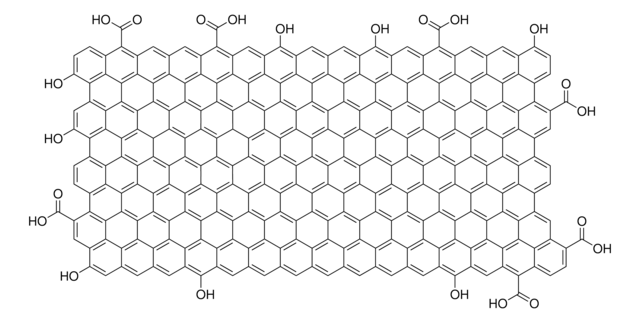808121
Expandable Graphite
flakes
Synonim(y):
Graphite intercalation compound, Intumescent flake graphite
Zaloguj sięWyświetlanie cen organizacyjnych i kontraktowych
About This Item
Wzór liniowy:
C24(HSO4)(H2SO4)2
Kod UNSPSC:
12352200
NACRES:
NA.23
Polecane produkty
opis
Expansion Ratio (X:1): 270 to 325
Poziom jakości
Postać
flakes
wielkość cząstki
+50 mesh (>300μ, ≥75% minimum)
pH
5-10
rozpuszczalność
water: insoluble
Opis ogólny
Expandable graphite is a synthesized intercalation compound of graphite that expands or exfoliates when heated. This material is manufactured by treating flake graphite with various intercalation reagents that migrate between the graphene layers in a graphite crystal and remain as stable species.
If exposed to a rapid increase in temperature, these intercalation compounds decompose into gaseous products, which results in high inter-graphene layer pressure. This pressure develops enough force to push apart graphite basal planes in the “c” axis direction. The result is an increase in the volume of the graphite of up to 300 times, a lowering of bulk density, and approximately a 10-fold increase in surface area.
If exposed to a rapid increase in temperature, these intercalation compounds decompose into gaseous products, which results in high inter-graphene layer pressure. This pressure develops enough force to push apart graphite basal planes in the “c” axis direction. The result is an increase in the volume of the graphite of up to 300 times, a lowering of bulk density, and approximately a 10-fold increase in surface area.
Zastosowanie
- Graphene precursor.
- Inorganic source of carbon.
- Filler.
- Thermal additive.
- Fire retardant additive.
- Casting powders.
- Plastic additive.
- Rubber additive.
- EMF absorber.
- Milling and sieving.
- Bulk loading, unloading.
- Base material for gaskets and seals.
- Coatings.
This page may contain text that has been machine translated.
Hasło ostrzegawcze
Warning
Zwroty wskazujące rodzaj zagrożenia
Zwroty wskazujące środki ostrożności
Klasyfikacja zagrożeń
STOT RE 2 Inhalation
Organy docelowe
Lungs
Kod klasy składowania
13 - Non Combustible Solids
Klasa zagrożenia wodnego (WGK)
WGK 1
Temperatura zapłonu (°F)
Not applicable
Temperatura zapłonu (°C)
Not applicable
Certyfikaty analizy (CoA)
Poszukaj Certyfikaty analizy (CoA), wpisując numer partii/serii produktów. Numery serii i partii można znaleźć na etykiecie produktu po słowach „seria” lub „partia”.
Masz już ten produkt?
Dokumenty związane z niedawno zakupionymi produktami zostały zamieszczone w Bibliotece dokumentów.
Klienci oglądali również te produkty
Siegfried Eigler
Chemical communications (Cambridge, England), 51(15), 3162-3165 (2015-01-22)
Graphite sulphate is used as a precursor to graphene for the first time. The positively charged graphene layers react with water to yield a processable graphene derivative. The unprecedented low density of defects is determined to be 0.06% on average
Electrochemical reactivation of expanded graphite electrodes covered by oligomeric products of phenol electrooxidation.
Krawczyk P, and Skowronski, JM.
Electrochimica Acta, 79, 202-209 (2012)
Nicolas R Tanguy et al.
ChemSusChem, 14(4), 1057-1067 (2020-11-28)
The increasing demand for wearable electronics has driven the development of supercapacitor electrode materials toward enhanced energy density, while being mechanically strong, flexible, as well as environmentally friendly and low-cost. Taking advantage of faradaic reaction of quinone groups in natural
Ayrat M Dimiev et al.
ACS nano, 6(9), 7842-7849 (2012-08-14)
Graphite intercalation compounds (GICs) can be considered stacks of individual doped graphene layers. Here we demonstrate a reversible formation of sulfuric acid-based GICs using ammonium persulfate as the chemical oxidizing agent. No covalent chemical oxidation leading to the formation of
Nasz zespół naukowców ma doświadczenie we wszystkich obszarach badań, w tym w naukach przyrodniczych, materiałoznawstwie, syntezie chemicznej, chromatografii, analityce i wielu innych dziedzinach.
Skontaktuj się z zespołem ds. pomocy technicznej









